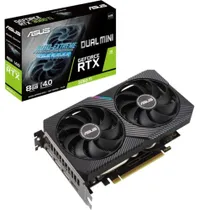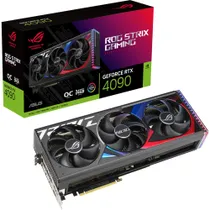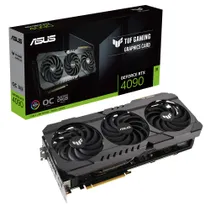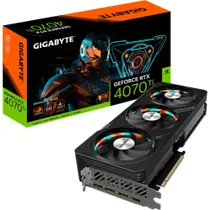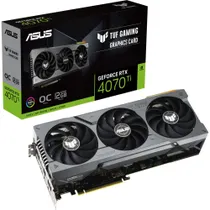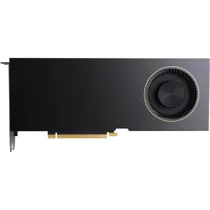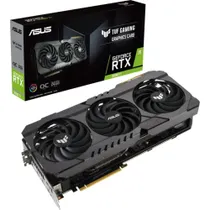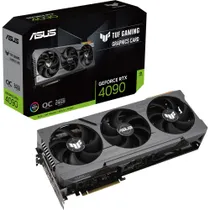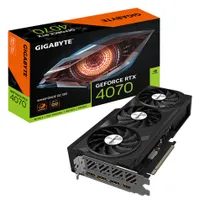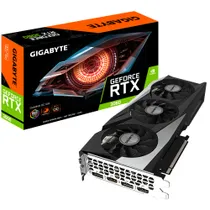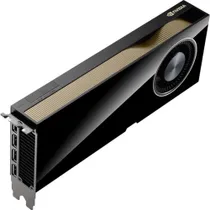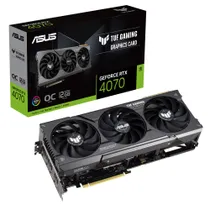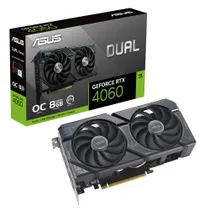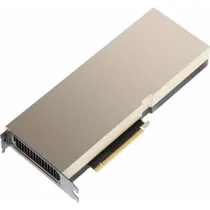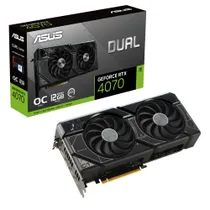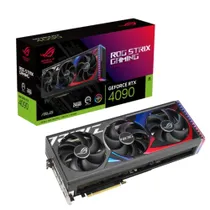- NVIDIA® GeForce RTX™ 3060 (LHR), Overclocked
- 12 GB GDDR6 (192bit), Connection via PCIe 4.0
- Active Cooling (Dual-Slot), RGB beleuchtet
- 1x HDMI, 3x DisplayPort
- Power Supply: 1x 8pin, 650 W PSU recommended
- Card length approx. 200 mm
- NVIDIA® GeForce® RTX 4090, Overclocked
- 24 GB GDDR6X (384bit), Connection via PCIe 4.0
- Active Cooling (Quad-Slot), RGB beleuchtet
- 2x HDMI, 3x DisplayPort
- Power Supply: 1x 16pin (12VHPWR), 1000 W PSU recommended
- Card length approx. 358 mm
- Ada Lovelace Architektur, mit Raytracing und DLSS 3
- NVIDIA® GeForce® RTX 4090, Overclocked
- 24 GB GDDR6X (384bit), Connection via PCIe 4.0
- Active Cooling (Quad-Slot), RGB beleuchtet
- 2x HDMI, 3x DisplayPort
- Power Supply: 1x 16pin (12VHPWR), 850 W PSU recommended
- Card length approx. 326 mm
- Ada Lovelace Architektur, mit Raytracing und DLSS 3
- NVIDIA® GeForce® RTX 4070Ti, Overclocked
- 12 GB GDDR6X (192bit), Connection via PCIe 4.0
- Active Cooling (Tri-Slot), RGB beleuchtet
- 1x HDMI, 3x DisplayPort
- Power Supply: 1x 16pin (12VHPWR), 750 W PSU recommended
- Card length approx. 300 mm
- Ada Lovelace Architektur, mit Raytracing und DLSS 3
- NVIDIA® GeForce® RTX 4070Ti, Overclocked
- 12 GB GDDR6X (192bit), Connection via PCIe 4.0
- Active Cooling (Quad-Slot), RGB beleuchtet
- 2x HDMI, 3x DisplayPort
- Power Supply: 1x 16pin (12VHPWR), 750 W PSU recommended
- Card length approx. 305 mm
- Ada Lovelace Architektur, mit Raytracing und DLSS 3
- NVIDIA® RTX™ A6000
- 48 GB GDDR6 (384bit), Connection via PCIe 4.0
- Active Cooling (Dual-Slot)
- 4x DisplayPort
- Power Supply: 1x 8pin, 300 W PSU recommended
- Card length approx. 268 mm
- NVIDIA® GeForce® RTX 3090 Ti, Overclocked
- 24 GB GDDR6X (384bit), Connection via PCIe 4.0
- Active Cooling (Tri-Slot), RGB beleuchtet
- 2x HDMI, 3x DisplayPort
- Power Supply: 1x 16pin (12VHPWR), 1000 W PSU recommended
- Card length approx. 326 mm
- NVIDIA® GeForce® RTX 4090, Overclocked
- 24 GB GDDR6X (384bit), Connection via PCIe 4.0
- Active Cooling (Quad-Slot), RGB beleuchtet
- 2x HDMI, 3x DisplayPort
- Power Supply: 1x 16pin (12VHPWR), 1000 W PSU recommended
- Card length approx. 358 mm
- Ada Lovelace Architektur, mit Raytracing und DLSS 3
- NVIDIA® GeForce® RTX 4090, Overclocked
- 24 GB GDDR6X (384bit), Connection via PCIe 4.0
- Active Cooling (Quad-Slot), RGB beleuchtet
- 2x HDMI, 3x DisplayPort
- Power Supply: 1x 16pin (12VHPWR), 850 W PSU recommended
- Card length approx. 348 mm
- Ada Lovelace Architektur, mit Raytracing und DLSS 3
- NVIDIA® GeForce® RTX 4070, Overclocked
- 12 GB GDDR6X (192bit), Connection via PCIe 4.0
- Active Cooling (Tri-Slot)
- 1x HDMI, 3x DisplayPort
- Power Supply: 1x 8pin, 650 W PSU recommended
- Card length approx. 261 mm
- Ada Lovelace Architektur, mit Raytracing und DLSS 3
- NVIDIA® GeForce® GT 730
- 2.0 GB GDDR5 (64bit), Connection via 2.0
- Passive Cooling (Single-Slot)
- 4x HDMI
- 300 W PSU recommended
- Card length approx. 148 mm
- NVIDIA® GeForce RTX™ 3060 (LHR), Overclocked
- 12 GB GDDR6 (192bit), Connection via PCIe 4.0
- Active Cooling (Dual-Slot), RGB beleuchtet
- 2x HDMI, 2x DisplayPort
- Power Supply: 1x 8pin, 550 W PSU recommended
- Card length approx. 282 mm
- NVIDIA® RTX™ 6000
- 48 GB GDDR6 (384bit), Connection via PCIe 4.0
- Active Cooling (Dual-Slot)
- 4x DisplayPort
- Power Supply: 1x 16pin (12VHPWR)
- Card length approx. 268 mm
- NVIDIA® A4000
- 16.0 GB GDDR6 (256bit), Connection via PCIe 4.0
- Active Cooling (Dual-Slot)
- 4x DisplayPort
- Power Supply: 1x 6pin
- Card length approx. 241 mm
- NVIDIA® GeForce® RTX 4070, Overclocked
- 12 GB GDDR6X (192bit), Connection via PCIe 4.0
- Active Cooling (Quad-Slot), RGB beleuchtet
- 1x HDMI, 3x DisplayPort
- Power Supply: 1x 8pin, 650 W PSU recommended
- Card length approx. 303 mm
- Ada Lovelace Architektur, mit Raytracing und DLSS 3
- NVIDIA® GeForce® RTX 4060, Overclocked
- 8.0 GB GDDR6 (128bit), Connection via PCIe 4.0
- Active Cooling (Dual-Slot)
- 1x HDMI, 3x DisplayPort
- Power Supply: 1x 8pin, 550 W PSU recommended
- Card length approx. 227 mm
- Ada Lovelace Architektur, mit Raytracing und DLSS 3
- NVIDIA® A40
- 48 GB GDDR6 (384bit), Connection via PCIe 4.0
- Passive Cooling (Dual-Slot)
- Card length approx. 267 mm
- NVIDIA® GeForce® RTX 4060, Overclocked
- 8.0 GB GDDR6 (128bit), Connection via PCIe 4.0
- Active Cooling (Dual-Slot)
- 1x HDMI, 3x DisplayPort
- Power Supply: 1x 8pin, 550 W PSU recommended
- Card length approx. 199 mm
- Ada Lovelace Architektur, mit Raytracing und DLSS 3
- NVIDIA® GeForce® RTX 4070, Overclocked
- 12 GB GDDR6X (192bit), Connection via PCIe 4.0
- Active Cooling (Tri-Slot)
- 1x HDMI, 3x DisplayPort
- Power Supply: 1x 8pin, 650 W PSU recommended
- Card length approx. 269 mm
- Ada Lovelace Architektur, mit Raytracing und DLSS 3
- NVIDIA® GeForce® RTX 4090
- 24 GB GDDR6X (384bit), Connection via PCIe 4.0
- Active Cooling (Quad-Slot), RGB beleuchtet
- 2x HDMI, 3x DisplayPort
- Power Supply: 1x 16pin (12VHPWR), 1000 W PSU recommended
- Card length approx. 358 mm
- Ada Lovelace Architektur, mit Raytracing und DLSS 3
- ...
Modern games are only as good as the graphics card that is installed in the computer. NVIDIA graphics cards offer exceptional performance and are not only an absolute highlight for gamers.
- What distinguishes an NVIDIA graphics card?
- Which NVIDIA graphics card for which budget?
- For which applications which NVIDIA graphics cards?
- What types of connectors do NVIDIA graphics cards have?
- What does the MHz number (clock rate) mean for a graphics card?
- Does an NVIDIA graphics card always need to be cooled?
Specialists in all areas - NVIDIA graphics cards
It's finally been released, the new game you've been waiting for for so long. Off into the computer with it and off it goes. At the beginning it runs quite well, but then it hangs in more and more places. You know that this is due to your old graphics card. Now you've had enough, you finally want to be able to play really well again and treat yourself to a brand new NVIDIA graphics card. Are you still looking for a suitable model? Our guide tells you which NVIDIA graphics cards are available and what you should look for when buying one.
NVIDIA is a manufacturer from the USA that can already look back on a 30-year success story. Today, the company is the largest developer of graphics processors, or GPUs for short. NVIDIA is considered a pioneer in the industry and has set itself the goal of basically always getting the maximum performance out of every single model. Graphics cards are very important for the image output on the monitor. The better and higher quality the graphics card is, the better the image can be reproduced. NVIDIA graphics cards are especially popular in the gaming sector. The desire for graphics cards that enable very good 3D graphics is always particularly high among gamers. NVIDIA does everything it can to develop the right processors to meet all requirements. It is important to know that NVIDIA only develops the graphics processors and chipsets, but does not manufacture them itself. That is done by other companies. This is perhaps one reason why NVIDIA is so effective, as it can focus purely on developing new processors and chipsets. NVIDIA is now the absolute market leader in the field of visual computing. Meanwhile, development has reached the point where the company's graphics cards use AI. As a result, the graphics cards achieve a performance that has never existed before.
NVIDIA graphics cards are particularly popular because they have quite low power consumption. This means that the GPU does not generate extreme heat even when it is working under full load. The cooler, which is responsible for the graphics card, can easily lower the temperature. Accordingly, it doesn't get nearly as hot in the case. Simple NVIDIA graphics cards could even theoretically manage without a cooler. However, it is recommended to always cool the graphics cards to ensure proper functioning. Moreover, the GPU of a graphics card from NVIDIA can be overclocked if properly cooled. This option is not only very interesting for gamers. If a gamer is asked which graphics card he would like to have, he will almost certainly choose a model from NVIDIA.
Of course, absolutely high-quality high-end graphics cards are not exactly cheap. However, not everyone needs such a high-end card. NVIDIA does develop a lot of high-performance graphics cards, but there are also a lot of somewhat simpler models on offer, so everyone can afford one. Here is a short overview:
- Graphics cards performance level entry level
NVIDIA offers some very affordable graphics cards. These are designed to be energy-efficient and are more suitable for simple applications. The NVIDIA GeForce GT graphics cards are a very good choice in this area. They are optimally suited for office tasks and simple multimedia tasks.
- Graphics cards performance level enthusiast for the middle budget
For newcomers to the world of gaming, graphics cards from this range are very well suited. This is where the NVIDIA GTX series come into play. Graphics cards from the NVIDIA GTX 10 series offer a particularly good price-performance ratio. The NVIDIA GTX 1050 graphics card is particularly popular. It offers a high refresh rate, which can, however, lead to a few compromises in the quality settings.
- Graphics card performance class Mid Range in the upper mid-range
NVIDIA graphics cards from the 16 series belong to this price category. They all offer refresh rates up to 144 Hz and thus provide a very special gaming experience in high-resolution Full HD.
- Graphics cards performance class high-end
The high-end segment of NVIDIA graphics cards is the absolute top class. The RTX graphics cards have secured a firm place here. They offer everything for exciting 4K gaming and have many other useful features besides ray tracing. With PCI Express Graphics Cards from this series, there are no limits for breathtaking gaming. The NVIDIA GeForce® RTX 2060 Grphics Cards has become the most popular model.
A graphics card with an NVIDIA chipset can have different connections. The HDMI, DisplayPort and Mini DisplayPort connections are available.
- HDMI
HDMI is the abbreviation for High Definition Multimedia Interface. HDMI not only enables a very high resolution, but also audio signals can be transmitted from the graphics card to the monitor. The data rate of HDMI is constantly increased, thus there are always higher resolutions and color depths. Up to now HDMI 2.0 was the latest standard. It allows a resolution of 60 Hz at a data rate of 14.4 GBit/s. All current graphics cards from NVIDIA support this standard. However, HDMI 2.1 is now already available, increasing the data rate to 42.3 GBit/s. This makes resolutions of up to 7680 x 4320 pixels possible at 60 Hz. NVIDIA has now released the first graphics card with HDMI 2.1. The RTX 3090 offers a computing power of 36 teraflops. It also has the AV1 codec, which enables it to display games and videos in 8K.
- DisplayPort / Mini DisplayPort
DisplayPort is a standard for the transmission of digital image and sound signals, which has become established alongside the HDMI standard. So-called lanes are used with the DisplayPort. These are four lanes, which became faster over time. As a result, the total bandwidth increased more and more. This standard is mainly used to connect monitors to PCs or laptops. It is used by NVIDIA in the current GeForce RTX cards, for example the NVIDIA RTX 2060, in version 1.4. It is possible to achieve 8.1 GBit/s per lane via HBR3 here. Together, this results in a data rate of 32.4 GBit/s. The Mini DisplayPort is a smaller version of the original DisplayPort. It is compatible with it. The Mini DisplayPort was introduced by Apple in 2008 as a proprietary technology, and one year later it was included in the DisplayPort specification.
Modern graphics cards usually have their own working memory. The chip and memory clock of a graphics card shows how many switching operations the graphics memory or the graphics processor of a graphics card can perform in one second. The clock is specified in MHz. Simply put, this means that the higher the clock frequency of the graphics processor and graphics memory, the faster the card can process information. This affects the quality of the images, which gets better and better the faster the information is processed. However, it is not only about the clock frequencies, the conversion of the clock rates between these components also plays an important role. This is about the number of data paths on which the information flows between the components. This means that a graphics card with a lower chip and memory clock can definitely also perform very well if the data paths are correspondingly wide. If you want to buy an NVIDIA graphics card, you should of course pay attention to the clock rate, but you should not disregard this point either.
NVIDIA graphics cards - simply one class better
The decades of experience NVIDIA can look back on are always noticeable in the products. The development never stands still, new, even more innovative graphics cards are designed again and again. They enable absolute top performance when it comes to playing demanding games, but also in video editing. In many multimedia applications, the hardware acceleration of NVIDIA graphics cards is able to actively support the work of the computer's processor through parallel computation. GeForce graphics cards from NVIDIA have become an indispensable part of the gaming world. They are optimized for 3D calculations and enable an absolutely smooth gaming experience. NVIDIA offers exactly the right graphics cards for every wish and every possible application. From graphics cards for beginners to models for everyday use to absolute professional variants, NVIDIA leaves nothing to be desired.

